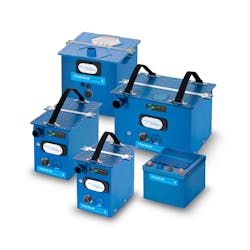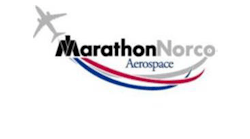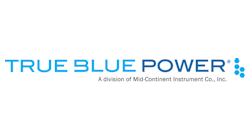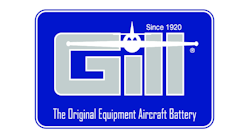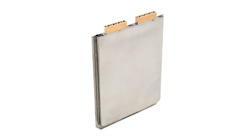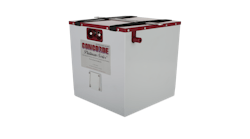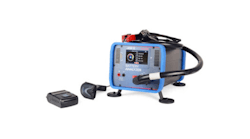Main ship batteries are a flight-critical component that play a key safety role onboard an aircraft. Manufacturers of these batteries, whether they are Nickel-cadmium (NiCd), Lithium Ion (Li-ion) or lead-acid, are constantly staying up-to-date, using the latest technologies to safely and effectively power an aircraft.
Nickel-Cadmium
Batteries are the last link in the emergency chain, playing an essential part in aircraft safety. Because of this, the condition of a battery must be verified by maintenance in order to ensure the safety of the passengers onboard – whether that includes one person, the pilot, onboard his or her personal plane, or 200 passengers on a commercial airliner.
“Not surprisingly, the technological development of aviation batteries has occurred in parallel with the technological development of airplanes,” explained Jean Marc Thevenound, aviation marketing manager at Saft Aviation.
Saft Aviation has been working in the industry since the 1930s and today supplies batteries to commercial aircraft, regional aircraft, business jets, helicopters and military aircraft, including drones. Saft’s 28 Volt NiCd and li-ion battery solutions provide power for the engine, or APU starting and emergency backup.
The latest generation of NiCd batteries from Saft are the ULM (Ultra Low Maintenance technology) batteries. “Our ULM batteries cut the need for maintenance in half, all while providing our usual levels of performance and quality,” mentioned Thevenound. “Saft ULM batteries are ideal for both new installations and upgrades since they are direct interchangeable with standard products in form, fit and function.”
Recently, Boeing awarded Saft a contract to fit all its new 777 and 777x airliners with onboard rechargeable NiCd battery systems, comprising of ULM Eversky batteries combined with a dedicated charger. “The new Saft battery system is designed to offer Boeing 777 operator’s superior performance and a lower total cost of ownership due to extended maintenance intervals,” Thevenound noted. “The maintenance interval is the period where correct operation is assured with low probability of failure and allows high levels of mean time between unscheduled removals and mean time between failures to be achieved. Apart from the question of safety, the avoidance of failure on board the aircraft, with consequent costly impact on delays, reduces operational costs.”
Additionally, Saft offers airlines its Skyzen battery, which enables maintenance intervals to be doubled. Skyzen is now in service on the Airbus A320 family of aircraft, providing safe and reliable power to start the APU, as well as emergency and backup for critical systems.
Safety is not only a concern with how the battery functions on a plane itself, but serious injury can result from carelessness while handling and working with Ni-Cd batteries during maintenance checks and installations, so it is important to take necessary precautions. “Tools used to service the NiCd batteries should be insulated. Metal tools dropped on the battery could short-circuit connectors and cause arcing which could not only damage the battery but injure the technician,” Thevenound explained. “The potassium hydroxide and water solution that forms the electrolyte is caustic and can cause serious burns if it comes in contact with the skin.”
Wear protective clothing, such as rubber gloves, goggles and a rubber apron while handling the solution. “If any electrolyte does come into contact with the skin, the aera should be flushed immediately,” Thevenound pointed out.
All aircraft require checking and maintaining the batteries in order to ensure their safety of operation when installed and ability to perform required functions. Maintenance checks also permit any problems to be identified and rectified. Saft has developed optimized maintenance procedures for its batteries to ensure safety, maximum service life and a high-level of performance. “In fact, up to 85 percent of the life of an engine is consumed during start sequences. So, having a battery designed to deliver the necessary power and energy when required is crucial,” Thevenound said. “The only way to achieve this is to work directly with original equipment manufacturers (OEMs) right from the start of the conception of the battery.”
Something else to keep in mind is the shelf life of the battery. “Many other battery offerings have a restricted shelf life once initially charged before having to be recharged or scrapped,” explained Chris Skwarek, director of sales and marketing for MarathonNorco Aerospace said. “This is a variable by chemistry, but to extend this time available to operate before timing out, Marathon manufactures multi-use or battery-specific Trickle Chargers via the Christie product portfolio. When paired with our battery, this offers 300 percent more time on-shelf versus most other solutions.”
Manufacturers of NiCd batteries note that these types of batteries continue to provide a safe, thoroughly tested, solution for aircraft. “This track record of safety allows operators to drop-in batteries to their aircraft without having to make expensive modifications to aeras that would be damaged by extreme thermal events or toxic fumes,” Skwarek explained.
MarathonNorco has been in continuous production ever since they first started manufacturing NiCd batteries in 1958. “MarathonNorco batteries are designed to handle typical starting loads that the selected aircraft would experience,” Skwarek said.
The MarathonNorco Micro Maintenance (M^3) batteries power helicopters, large commercial, regional, military and corporate aircraft. “The M^3 batteries are Federal Aviation Administration - Parts Manufacturer Approved for many aircraft models, ranging from 17 to 75 ampere-hours, and are interchangeable with existing batteries. Marathon offers the ability to easily make the change to a low-maintenance battery without aircraft modifications and service through existing battery shop equipment,” Skwarek noted.
The M^3 batteries are designed for longer on-wing time between servicing. “The specially-designed polymer-bonded negative electrolyte has two and a half times the active material than the standard electrode, allowing for a smaller plate and larger amounts of electrolyte,” added Skwarek. “Our customer experience includes support form a technical team partnering with operators to review their batteries throughout the life-cycle and extend maintenance intervals based on use.”
The M^3 batteries can help operators reduce their operational cost by extending the time in service beyond what is recommended by the aircraft manufacture.
These batteries are the same physical size as the standard batteries and allow operators to reduce their battery maintenance cost by increasing service interval by up to eight times the original service interval, Skwarek added.
Historically, the Marathon SuperPower Batteries are most frequently selected for engine starting and emergency power in commercial, corporate and military aircraft-fixed wing and rotary applications. They’re rechargeable vented NiCd batteries. “The Superpower Battery product line has been designed to provide maximum power for engine and APU starting applications and offer improved starting in challenging environments,” Skwarek said.
MarathonNorco maintains a fully staffed Engineering Department capable of designing and developing batteries to meet the customers requirements. Most of the Marathon Batteries contain special harness assemblies that provide information to the pilot. These harness assemblies have been engineered to work with the mist sensitive digital flight systems.
The company also offers heated batteries for certain applications which can be heated during service or while on the tarmac. “This ensures easy engine starts at temperatures well below -40 degrees Fahrenheit,” Skwarek said.
The temperature will affect all batteries’ ability to provide the necessary power for the aircraft, Skwarek added. “MarathonNorco batteries can provide engine-starting power at temperatures between -30 degrees Fahrenheit up to 160 degrees Fahrenheit without a heater blanket or additional cooling provisions. MarathonNorco batteries can be discharged all the way to 0V without any permanent damage.”
Lithium-ion
Li-ion technology is the latest generation of batteries and are lighter than tradition nickel-based batteries with better energy density and require less maintenance. There are multiple forms of li-ion batteries, which vary in composition and construction.
“True Blue Power batteries use the safest li-ion chemistry available,” explained Todd Winter, president and CEO of True Blue Power. “Our batteries provide aviators with an unmatched advantage of increased power, significantly reduced weight, less maintenance, lower overall cost of ownership and extended useful life.”
Winter continued: “We recently announced the certification of our new fifth-generation (Gen5) li-ion main ship battery family. The new, on-condition TB20 (20 amp-hour), TB30 (30 amp-hour) and TB40 (40 amp-hour) received an impressive C179b Class A-4B rating, meeting the FAA’s latest and highest level of lithium battery requirements.”
True Blue Power batteries are designed to meet the needs of a variety of aircraft and platforms. Several of the company’s partners are pursuing new STCs (Supplemental Type Certification) for their batteries on roto and fixed-wing aircraft. “Airwolf Aerospace, for example, is in the process of securing STCs with our li-ion main ship batteries for 18 helicopter models,” Winter explained. “Our goal is to make things easier for OEMs, owners, operators and technicians by supplying an intelligent battery system that satisfies their airframe and operating requirements.”
True Blue Power li-ion batteries are FAA-certified and are designed with a built-in automatic heater. They do not need to be removed from the aircraft in extreme cold temperatures and deliver both superior high temperature and cold weather performance (-40 degrees Celsius to +70 degrees Celsius).
“Our main ship batteries feature an intelligent Battery Management System (BMS), which are engineered to protect against overcharge, over discharge, over-current, short circuit, over-temperature and under-temperature,” Winter noted. “NanoPhosphate is stable chemically, providing the foundation for safe systems. It delivers superior safety and abuse tolerance compared to metal oxide li-ion chemistries.”
Lead-Acid
Lead-acid batteries have been used in the aviation industry for years and years and is still powering engines to this day. It is the go-to battery type when it comes to powering aircraft, says lead-acid battery manufacturer Teledyne Battery Products.
“Our Gill Sealed, VRLA lead-acid aircraft batteries and dry-charge lead-acid batteries are used in piston aircraft, turboprops and business jets,” said Tom Jones, sales and marketing at Teledyne Battery Products.
